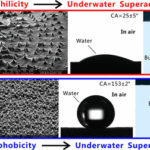Paper,Bioinspired Design of Underwater Superaerophobic and Superaerophilic Surfaces by Femtosecond Laser Ablation for Anti- or Capturing Bubbles
A micro-/nanoscale hierarchical rough structure inspired by the underwater superaerophobicity of fish scales was fabricated by ablation of a silicon surface by a femtosecond laser. The resultant silicon surface showed superhydrophilicity in air and became superaerophobic after immersion in water. Additionally, inspired by the underwater superaerophilicity of lotus leaves, we showed that the polydimethylsiloxane surface after femtosecond laser ablation exhibits superhydrophobicity in air and becomes superaerophilic in water. The underwater superaerophobic surface showed excellent antibubble ability, whereas the underwater superaerophilic surface could absorb and capture air bubbles in a water medium. The experimental results revealed that the in-air superhydrophilic surface generally shows superaerophobicity in water and that the in-air superhydrophobic surface generally shows underwater superaerophilicity. An underwater superaerophobic porous aluminum sheet with through microholes was prepared, and this sheet was able to intercept underwater bubbles and further remove bubbles from water. In contrast, the underwater superaerophilic porous polytetrafluoroethylene sheet could allow the bubbles to pass through the sheet. We believe that these results are highly significant for providing guidance to researchers and engineers for obtaining excellent control of bubbles’ behavior on a solid surface in a water medium.
Learn about our two Decals!
 Click here to find out more about our Fall Bioinspired Design Decal and our Spring Bioinspired Design in Action Decal – ALL MAJORS are welcome.
Click here to find out more about our Fall Bioinspired Design Decal and our Spring Bioinspired Design in Action Decal – ALL MAJORS are welcome.Berkeley BioDesign Community
 Click here to learn about the BioD: Bio-Inspired Design @ Berkeley student organization or here to signup for more info.
Click here to learn about the BioD: Bio-Inspired Design @ Berkeley student organization or here to signup for more info.Search
Student Login




I imagine that the neurological circuits underlying these processes are governed by both 2d spacing maps with their brains as…
to reduce the impact of car accidents, it may be possible to study the force diverting physics of cockroaches to…
you see this type of head-bobbing stability in many avian creatures related to pigeons like chickens. the head ability to…
not like they taught horses how to run! this is an example of convergent evolution where both sea creatures and…
The brain functions in a similar way with neuronal connections. our brains are able to utilize the multiplicity of connections…